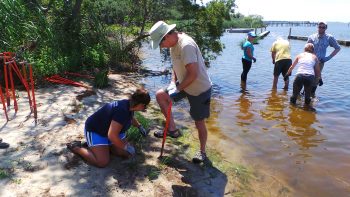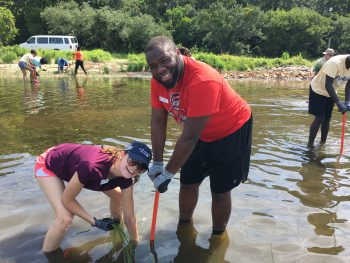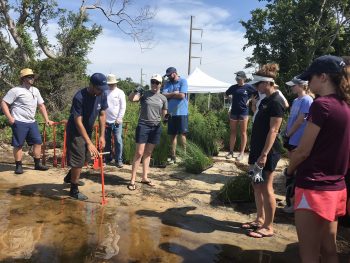
WANCHESE — Over the course of two weeks, on some of the hottest days this summer has seen, over 100 volunteers braved the elements to join the North Carolina Coastal Federation, Town of Kitty Hawk, landowners and Dare Soil and Water Conservation District to plant marsh grasses at the Moor Shore Road living shoreline project site in Kitty Hawk. Nearly 10,000 plugs of black needlerush, a native marsh grass species, were planted along the length of the 600-foot project. With these plantings, the Kitty Hawk living shoreline project is complete.
“I’ve lived on the water my whole life, it and this land have given me so much. It’s an honor to have a chance to give something back,” said Mayor Gary Perry, upon welcoming the volunteers to the planting. “Thank you for being here.”

The project is a culmination of multiple moving parts and groups coming together to successfully stabilize the shoreline along the historic road in Kitty Hawk and build back lost marsh habitat. The planning and construction of the offshore vertical sill included a partnership between the property owners along the road, the town of Kitty Hawk, the North Carolina Department of Transportation and Dare County Soil and Water.
This is a notable partnership as it represents the first living shoreline project in the state that has involved the Department of Transportation.
Once the sill was installed, marsh grasses were planted by various volunteer groups including Better Beaches OBX, Outer Banks Running Club, staff from the North Carolina Aquarium at Roanoke Island, a summer camp group from the Aquarium, 4-H Groups from Dare County and Camden County, River City YouthBuild of Elizabeth City, as well as individual community members. The generosity from the volunteer groups saved the federation and the town of Kitty Hawk a great deal of time and money. It also served as a great way to engage the community in the living shoreline project and help people understand the project’s value and importance.

“I’m so happy for the many benefits this marsh sill will provide to the community; providing wetland habitat for flood mitigation, wildlife and fisheries habitat, reducing shoreline erosion and filtering stormwater runoff,” said Ann Daisey of Dare County Soil and Water.
“The funding partners and partnerships created through this project showcase a perfect example of what we can accomplish together, especially when it comes to managing the county’s natural resource concerns. I’m proud that the Dare Soil and Water Conservation District played a part in securing funds from the state’s Community Conservation Assistance Program for this great project.”
The offshore sill serves as a speed bump for waves, helping to slow them and dissipate their energy and the recently planted marsh grasses help to further dissipate the waves and hold the shorelines sediment in place. In addition, the plants create habitat for wetland species like crabs, small fish and shrimp and improve water quality. Barring a big storm, the shoreline should stabilize and become a thriving example of a living shoreline project.
For more information on the project or how to pursue a living shoreline for your waterfront property, visit the federation’s website at nccoast.org/livingshorelines.
